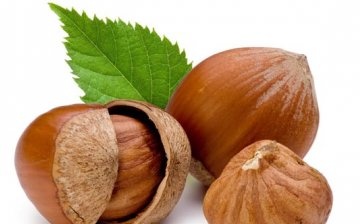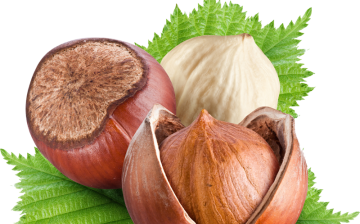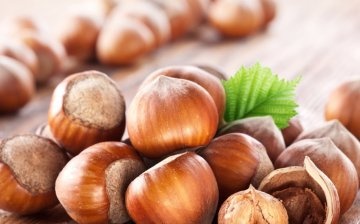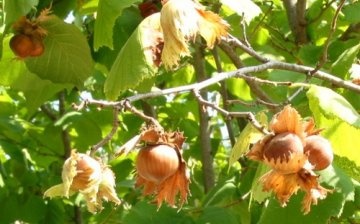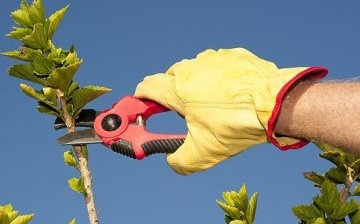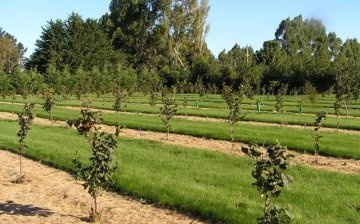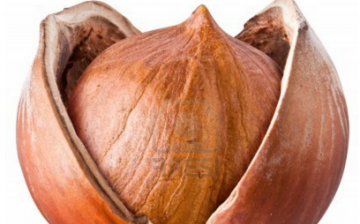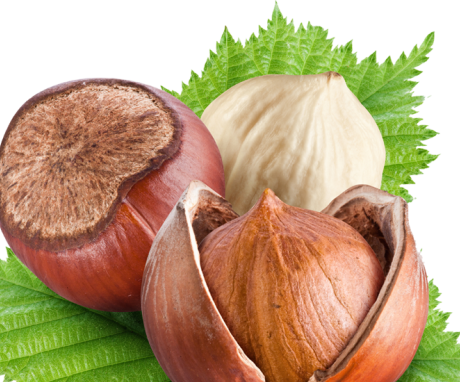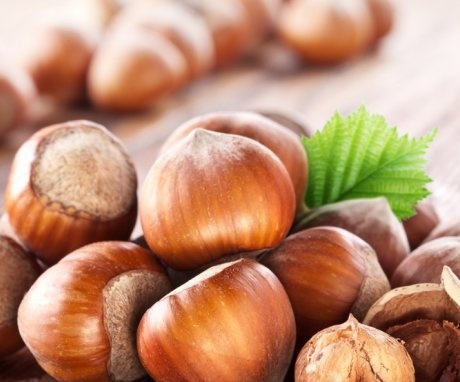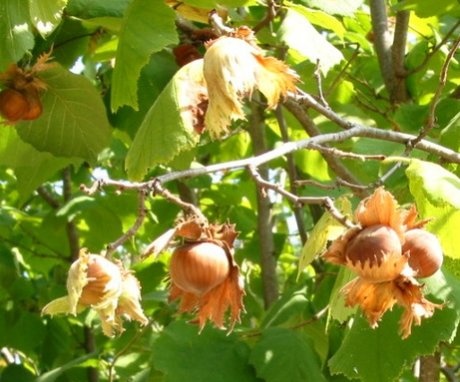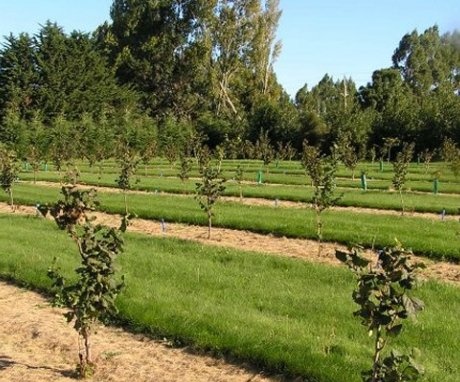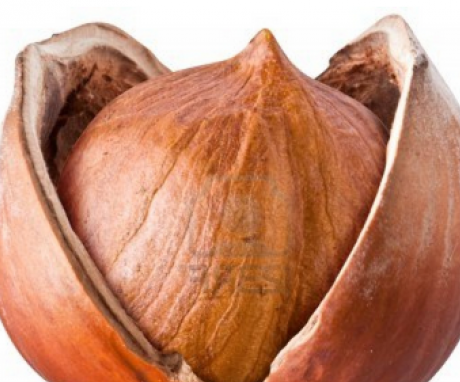Hazelnuts: characteristics, varieties, care, reproduction and useful properties
Hazelnut is an unpretentious plant and quite frost-resistant. With proper care, hazelnuts, planting and caring for which are described below, will yield a high yield every year.
Content:
- General information about hazelnuts
- Hazelnut varieties
- Hazelnut care
- Hazelnut pruning
- Reproduction of hazelnuts
- Useful properties of hazelnuts
General information about hazelnuts
Hazelnut is a domesticated species of hazel, hazelnut, belongs to the nut family... This plant looks like a perennial bush, the height of which is slightly more than 7 meters. The branches are thick, long, leaves are densely located on them, the shape of which can be oval or round, depending on the variety. The tip of the leaves is pointed, but they themselves are embossed and serrated along the edges.
This bush blooms in a period unusual for all plants - from December to March. Male flowers are formed on it - earrings and female flowers, small buds with barely visible red stigmas. All hazelnut flowers tolerate frosts down to -30 and retain their vital activity.
For pollination, the bush does not need insects, all processes take place with the help of the wind.
Hazelnut fruits are large and have a thin shell, which makes them different from wild plants. Ripening occurs at the end of summer and the beginning of autumn, but varieties with earlier ripening are also bred.
The homeland of hazelnut is the Black Sea coast, its eastern part. The word hazelnut itself is translated from Turkish as "from the Black Sea".
Hazelnut varieties
Hazelnut varieties:
- Sugar hazelnuts are a hybrid variety. The height of such a bush does not exceed 4 meters, the branches are of medium size, the leaves have a reddish tint. Due to this, the variety can also be classified as decorative. Sugar hazelnuts are a winter-hardy variety, therefore they are suitable for planting in cooler regions than their homeland.
- Hazelnut Crown - belongs to the early varieties. Fruit ripening occurs at the beginning of August. The branches of the bush stretch up to 5 meters. The yield is high, the nuts are large, sweetish.
- Hazelnut Valuable Webb. A tall shrub that brings a high yield every year, provided that there are other varieties on the site. The nuts are large, oblong and have a light shell shade. Usually 2-3 pieces are tied in a bunch, there are also more numerous ovaries.
- Hazelnut Cosford. The advantage of this hazelnut variety is that fruiting begins in the early years of the bush's life. The branches are high, large, forming a dense crown in the upper part of the bush. Cosford hazelnuts do not tolerate a strong drop in temperature, so it is recommended to plant it in warm regions. This variety is capable of self-pollination, but for a high yield, the proximity of other varieties is necessary.
- Hazelnut Borovsky. it fairly high-yielding hazelnut variety... The height of an adult bush reaches 5 meters. The plant is unpretentious and tolerates winter frosts well. Medium-sized fruits, up to about 2 cm, ripen by the end of August. Does not require regular removal of excess branches, as it is not prone to thickening.
- Hazelnut Morozivsky. This variety of hazelnuts is medium-sized, its height reaches only 4 meters. High-yielding, used for industrial purposes.The fruits are large, sweetish in taste. The ripening period begins at the end of August.
- Hazelnut Dolinsky. This variety is characterized by an early ripening period, it falls on the middle of August. Also, its advantage is that it is an excellent pollinator, which you should definitely have in an area with bushes of other varieties. Productivity is high, unpretentious, tolerates winter temperature drop well.
Hazelnut care
The hazelnut bush bears fruit only in bright areas that are well warmed up by the sun. Therefore, when planting, it is worth choosing a sunny place. Almost any soil suits him. Sandy and salty places should be avoided. A moisture-loving plant, hazelnuts, however, do not tolerate waterlogging. With an excess of water, the roots begin to rot, and the branches are affected by diseases. The bush can be planted on slopes.
Due to the fact that its roots are shallow, an adult hazelnut bush is an excellent plant for strengthening loose slopes.
The soil must be fertile and with good drainage. After rains and regular watering, it must be loosened around the bush, without deepening the tool below 15 cm, so as not to damage the root system.
Watering is necessary during a particularly hot period, which usually begins at the end of June. Also during this period, the formation of fruits takes place, which increases the moisture consumption of the plant.
Top dressing of the bush:
- Produced annually, mineral fertilizers are used for this.
- Organic matter is best applied once every three years, this increases the productivity of the bush well.
- It is worth avoiding nitrogenous fertilizers, which will make the bush beautiful and lush, with dense foliage, but will significantly reduce the quantity and quality of the crop.
Hazelnut bushes are resistant to diseases and pests. But for prevention in late October - early November and early spring, the branches are processed with iron vitriol. Sometimes powdery mildew appears on the leaves, such bushes must be treated with a solution of colloidal sulfur.
Warming for the winter is not required, since many varieties tolerate winter drops in temperature well. Nevertheless, due to the fact that the roots are located superficially, young bushes are sprinkled with dry foliage or sawdust for the winter. In early spring, they should be removed so as not to rot.
Hazelnut pruning
Hazelnut bush needs regular pruning and deleting unnecessary branches. The autumn months are suitable for this process. The formation of a bush begins already from 2 to 3 years of plant life. To do this, you need to select 5-8 large branches of the undergrowth, which are at a distance from each other.
These shoots will make up the bulk of the crown. The rest of the branches must be cut at the root. Formation takes place up to 5 years of age of the bush, after which it is simply thinned out and shoots are removed.
With a strong thickening of the bush, the yield decreases. Therefore, pruning should be carried out annually, removing excess internal branches.
An adult plant that has reached 11 years old needs to be rejuvenated annually. This process takes place in early spring. At the same time, old thick branches are removed, and in their place a large branch is selected from the overgrowth and the top is cut off on it to enhance branching.
Reproduction of hazelnuts
Hazelnut propagation can be done in two ways: seed and vegetative. The easiest way is to sow nuts. However, here it is worth considering some nuances. Basically, with this method of reproduction, daughter shrubs do not inherit the characteristics of the mother tree.
That is, the fruits may be smaller or the yield is significantly reduced. In rare cases, seed propagation produces a high-yielding bush with large fruits.
Propagation using seeds:
- Sowing takes place almost immediately after harvesting the nuts in September or October.
- Sowing can be postponed to the spring, but for this it is necessary to stratify the seeds.
- Put them in peat or wet sand and keep them at a temperature not higher than +6 degrees, but not lower than +1.
- Also, such nuts must be mixed once every 10-12 days in order for oxygen to get to them.
- When planting nuts, they are buried 8 cm in the autumn and no deeper than 5 cm in the spring.
- The plot is regularly loosened and weeds removed.
- Also, in the warm months, watering is necessary, the soil should not be dry for a long period. Such procedures are carried out up to 2 years of age of seedlings, when they can already be transplanted.
With vegetative propagation, all the characteristics of the mother bush are preserved.
Reproduction using layering:
- To do this, in early spring, a strong layering is tilted to the ground, a depression is made up to 15 cm and the shoot is placed in a hole.
- Sprinkle on top with fertile soil.
- The top must be left above the ground and tie it vertically to the support.
- The place where the shoot is prikopan must be regularly watered; when the soil dries out, young roots may die.
- It is possible to separate the daughter bush from the mother in the second year.
You can also propagate hazelnuts by dividing the rhizome:
- This process is carried out when transplanting a young bush.
- It is dug up, divided into the required number of parts so that 3-5 shoots remain on each new plant.
- After that, the hazelnuts are planted in pre-prepared holes.
- It is advisable to plant a young hazelnut bush in early spring or by mid-autumn. To do this, you need to prepare a pit, the size of which should be 50 cm in length, width and depth.
- The soil from the pit can be mixed with humus, superphosphate, and a fertilizer containing potassium. It is necessary to fill half of the hole with this mixture, forming a mound. After that, the seedling must be dipped in a clay solution, so immerse the entire root system.
- A bush is placed in the resulting depression, the roots of which are located on a mound, and covered with the remaining soil so that the root collar rises a couple of centimeters above the ground.
- It is advisable to leave a gap of at least 2 meters between the bushes.
- After the ground has been trampled down a little, the bush should be well watered and mulched. For this, sawdust or dry grass are suitable.
- To increase fertility, it is recommended to plant 2-3 different varieties of hazelnuts in one area.
Useful properties of hazelnuts
Hazelnut fruits are very useful, they contain 70% nut oil, which is well absorbed by the human body. Due to the content of polyunsaturated fatty acids, the use of hazelnuts in food improves metabolism and excretion of toxins from the body. It also has a high protein content, which is not inferior in quantity to meat, and is much better absorbed. Therefore, hazelnuts are one of the favorite nuts of vegetarians.
In addition, hazelnut kernels contain a large amount of vitamins and minerals. It is recommended for people with increased physical and mental stress. If you mix chopped hazelnuts with dried apricots and honey, you get an excellent tool for the prevention of cardiovascular diseases.
Walnut is also a strong allergen, so this disadvantage should be taken into account when eating or using it.
Hazelnuts are widely used in the confectionery industry. Nuts are used in the preparation of sweets and cakes, halva and cookies, and in the production of many other delicacies.
Due to their high oil content, hazelnuts are used for the production of masks and other cosmetic products.
Also some varieties of hazelnuts used as ornamental shrubs... They are planted near houses and gazebos. Basically, these varieties have leaves painted in a red or reddish tint. By the fall, they become brighter, which will perfectly decorate any garden.
More information about hazelnuts can be found in the video.



